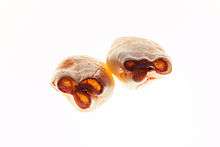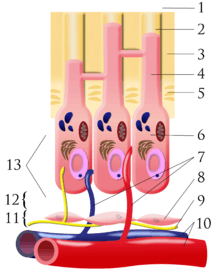Pulp (tooth)
| Pulp (tooth) | |
|---|---|
 Section of a human molar | |
| Details | |
| Identifiers | |
| Latin | pulpa dentis |
| MeSH | A14.549.167.900.260 |
| Dorlands /Elsevier | p_41/12679455 |
| TA | A05.1.03.051 |
| FMA | 55631 |
The dental pulp is the part in the center of a tooth made up of living connective tissue and cells called odontoblasts. The dental pulp is a part of the dentin–pulp complex (endodontium).[1] The vitality of the dentin-pulp complex, both during health and after injury, depends on pulp cell activity and the signaling processes that regulate the cell’s behavior.[2]
Anatomy

Each person can have a total of up to 52 pulp organs, 32 in the permanent and 20 in the primary teeth. The total volumes of all the permanent teeth organs is 0.38cc and the mean volume of a single adult human pulp is 0.02cc. Maxillary central incisor has shovel shaped coronal pulp with three short horns on the coronal roof and triangular in cross section. Canine has the longest pulp with elliptical cross section.
The large mass of pulp is contained within the pulp chamber of the tooth. The shape of each pulp chamber corresponds directly to the overall shape of the tooth, and thus is individualized for every tooth; the pulp tissue in the pulp chamber has two main divisions: coronal pulp and radicular pulp.[2] Crowns of the teeth contain coronal pulp. The coronal pulp has six surfaces: the occlusal, the mesial, the distal, the buccal, the lingual and the floor. Because of continuous deposition of dentin, the pulp becomes smaller with age. This is not uniform throughout the coronal pulp but progresses faster on the floor than on the roof or side walls.
Radicular pulp is that pulp extending from the cervical region of the crown to the root apex. They are not always straight but vary in shape, size and number. The radicular portion is continuous with the periapical tissues through the apical foramen or foramina.
Apical foramen is the opening of the radicular pulp into the periapical connective tissue. The average size is 0.3 to 0.4 mm in diameter. There can be two or more foramina separated by a portion of dentin and cementum or by cementum only. If more than one foramen is present on each root, the largest one is designated as the apical foramen and the rest are considered accessory foramina.[2] Most infections spread through the apical foramen from the pulp to periapical tissue.
Accessory canals are pathways from the radicular pulp, extending laterally through the dentin to the periodontal tissue seen especially in the apical third of the root. Accessory canals are also called lateral canals, because they are usually located on the lateral surface of the roots of the teeth.
Development
The pulp has a background similar to that of dentin, because both are derived from the dental papilla of the tooth germ. During odontogenesis, when the dentin forms around the dental papilla, the innermost tissue is considered pulp.[3]
Internal Structure

The central region of the coronal and radicular pulp contains large nerve trunks and blood vessels.
This area is lined peripherally by a specialized odontogenic area which has four layers (from innermost to outermost):
- Pulpal core, which is in the center of the pulp chamber with many cells and an extensive vascular supply; except for its location, it is very similar to the cell-rich zone.
- Cell rich zone; which contains fibroblasts and undifferentiated mesenchymal cells.
- Cell free zone (zone of Weil) which is rich in both capillaries and nerve networks.
- Odontoblastic layer; outermost layer which contains odontoblasts and lies next to the predentin and mature dentin.
Cells found in the dental pulp include fibroblasts (the principal cell), odontoblasts, defence cells like histiocytes, macrophage, granulocytes, mast cells and plasma cells.The nerve plexus of Raschkow is located central to the cell-free zone.[3]
The plexus of Raschkow
The plexus of Raschkow monitors painful sensations. By virtue of their peptide content they also play important functions in inflammatory events and subsequent tissue repair. There are two types of nerve fiber that mediate the sensation of pain: A-fibers conduct rapid and sharp pain sensations and belong to the myelinated group, whereas C-fibers are involved in dull aching pain and are thinner and unmyelinated. The A-fibers, mainly of the A-delta type, are preferentially located in the periphery of the pulp, where they are in close association with the odontoblasts and extend fibers to many but not all dentinal tubules. The C-fibers typically terminate in the pulp tissue proper, either as free nerve endings or as branches around blood vessels.
Functions
The primary function of the dental pulp is to form dentin (by the odontoblasts).
Other functions include:
- Nutritive: the pulp keeps the organic components of the surrounding mineralized tissue supplied with moisture and nutrients;
- Sensory: extremes in temperature, pressure, or trauma to the dentin or pulp are perceived as pain;
- Protective: the formation of reparative or secondary dentin (by the odontoblasts);
- Formative: cells of the pulp produce dentin which surrounds and protects the pulpal tissue.
Complications
Pulp acts as a security and alarm system for a tooth. Slight decay in tooth structure not extending to the dentin may not alarm the pulp but as the dentin gets exposed, either due to dental caries or trauma, sensitivity starts. The dentinal tubules pass the stimulus to odontoblastic layer of the pulp which in turns triggers the response. This mainly responds to cold. At this stage simple restorations can be performed for treatment. As the decay progresses near the pulp the response also magnifies and sensation to a hot diet as well as cold gets louder. At this stage indirect pulp capping might work for treatment but at times it is impossible to clinically diagnose the extent of decay, pulpitis may elicit at this stage. Carious dentin by dental decay progressing to pulp may get fractured during mastication (chewing food) causing direct trauma to the pulp hence eliciting pulpitis.
The inflammation of the pulp is known as pulpitis. Pulpitis can be extremely painful and in serious cases calls for root canal therapy or endodontic therapy.[4] Traumatized pulp starts an inflammatory response but due to the hard and closed surroundings of the pulp pressure builds inside the pulp chamber compressing the nerve fibres and eliciting extreme pain (acute pulpitis). At this stage the death of the pulp starts which eventually progresses to periapical abscess formation (chronic pulpitis).
The pulp horns recede with age. Also with increased age, the pulp undergoes a decrease in intercellular substance, water, and cells as it fills with an increased amount of collagen fibers.This decrease in cells is especially evident in the reduced number of undifferentiated mesenchymal cells. Thus, the pulp becomes more fibrotic with increased age, leading to a reduction in the regenerative capacity of the pulp due its loss of these cells. Also, the overall pulp cavity may be smaller by the addition of secondary or tertiary dentin, thus causing pulp recession. The lack of sensitivity associated with older teeth is due to receded pulp horns, pulp fibrosis, addition of dentin, or possibly all these age-related changes; many times restorative treatment can be performed without local anesthesia on older dentitions.[2]
See also
References
- ↑ http://endodontistrootcanal.com/endodontium/
- 1 2 3 4 Illustrated Dental Embryology, Histology, and Anatomy, Bath-Balogh and Fehrenbach, Elsevier, 2011, page 164.
- 1 2 Antonio Nanci, Ten Cate's Oral Histology, Elsevier, 2007, page 91
- ↑ http://www.animated-teeth.com/root_canal/t1_root_canal.htm
Additional images
-

Illustration of tooth anatomy.
External links
- An overview of the dental pulp: its functions and responses to injury, C Yu, PV Abbott, Australian Dental Journal Supplement 2007;52:(1 Suppl):S4-S16 at http://www.ada.org.au/app_cmslib/media/lib/0704/m70470_v1_633112728503963750.pdf
- Guideline on Pulp Therapy for Primary and Immature Permanent Teeth, REFERENCE MANUAL V 34 / NO 6 12 / 13, 2009, American Academy of Pediatric Dentistry at http://www.aapd.org/media/Policies_Guidelines/G_Pulp.pdf